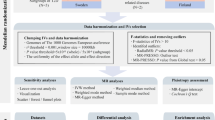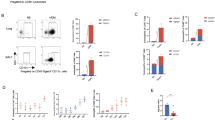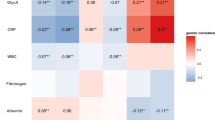Abstract
Sialic acid-binding immunoglobulin-like lectin-8 (Siglec-8) promotes the apoptosis of eosinophils and inhibits FcɛRI-dependent mediator release from mast cells. We investigated the genetic association between sequence variants in Siglec-8 and diagnosis of asthma, total levels of serum IgE (tIgE), and diagnosis of eosinophilic esophagitis (EE) in diverse populations. The effect of sequence variants on Siglec-8 glycan ligand-binding activity was also examined. Significant association with asthma was observed for SNP rs36498 (odds ratios (OR), 0.69, P=8.8 × 10−5) among African Americans and for SNP rs10409962 (Ser/Pro) in the Japanese population (OR, 0.69, P=0.019). Supporting this finding, we observed association between SNP rs36498 and current asthma among Brazilian families (P=0.013). Significant association with tIgE was observed for SNP rs6509541 among African Americans (P=0.016), and replicated among the Brazilian families (P=0.02). In contrast, no association was observed with EE in Caucasians. By using a synthetic polymer decorated with 6′-sulfo-sLex, a known Siglec-8 glycan ligand, we did not find any differences between the ligand-binding activity of HEK293 cells stably transfected with the rs10409962 risk allele or the WT allele. However, our association results suggest that the Siglec8 gene may be a susceptibility locus for asthma.
Similar content being viewed by others
Log in or create a free account to read this content
Gain free access to this article, as well as selected content from this journal and more on nature.com
or
References
von Gunten S, Bochner BS : Basic and clinical immunology of Siglecs. Ann N Y Acad Sci 2008; 1143: 61–82.
Kikly KK, Bochner BS, Freeman SD et al: Identification of SAF-2, a novel siglec expressed on eosinophils, mast cells, and basophils. J Allergy Clin Immunol 2000; 105: 1093–1100.
Bochner BS : Siglec-8 on human eosinophils and mast cells, and Siglec-F on murine eosinophils, are functionally related inhibitory receptors. Clin Exp Allergy 2009; 39: 317–324.
Bochner BS, Alvarez RA, Mehta P et al: Glycan array screening reveals a candidate ligand for Siglec-8. J Biol Chem 2005; 280: 4307–4312.
Nutku E, Aizawa H, Hudson SA, Bochner BS : Ligation of Siglec-8: a selective mechanism for induction of human eosinophil apoptosis. Blood 2003; 101: 5014–5020.
Nutku E, Hudson SA, Bochner BS : Mechanism of Siglec-8-induced human eosinophil apoptosis: role of caspases and mitochondrial injury. Biochem Biophys Res Commun 2005; 336: 918–924.
Nutku-Bilir E, Hudson SA, Bochner BS : Interleukin-5 priming of human eosinophils alters Siglec-8 mediated apoptosis pathways. Am J Respir Cell Mol Biol 2008; 38: 121–124.
Zimmermann N, McBride ML, Yamada Y et al: Siglec-F antibody administration to mice selectively reduces blood and tissue eosinophils. Allergy 2008; 63: 1156–1163.
Song DJ, Cho JY, Miller M et al: Anti-Siglec-F antibody inhibits oral egg allergen induced intestinal eosinophilic inflammation in a mouse model. Clin Immunol 2009; 131: 157–169.
Zhang M, Angata T, Cho JY, Miller M, Broide DH, Varki A : Defining the in vivo function of Siglec-F, a CD33-related Siglec expressed on mouse eosinophils. Blood 2007; 109: 4280–4287.
Bochner BS : Verdict in the case of therapies versus eosinophils: the jury is still out. J Allergy Clin Immunol 2004; 113: 3–9.
Rothenberg ME, Hogan SP . The eosinophil. Annu Rev Immunol 2006; 24: 147–174.
Koh YI, Choi S : Blood eosinophil counts for the prediction of the severity of exercise-induced bronchospasm in asthma. Respir Med 2002; 96: 120–125.
Jatakanon A, Lim S, Barnes PJ . Changes in sputum eosinophils predict loss of asthma control. Am J Respir Crit Care Med 2000; 161: 64–72.
Green RH, Brightling CE, McKenna S et al: Asthma exacerbations and sputum eosinophil counts: a randomised controlled trial. Lancet 2002; 360: 1715–1721.
Venanzi S, Malerba G, Galavotti R et al: Linkage to atopy on chromosome 19 in north-eastern Italian families with allergic asthma. Clin Exp Allergy 2001; 31: 1220–1224.
Ober C, Cox NJ, Abney M et al: Genome-wide search for asthma susceptibility loci in a founder population. The Collaborative Study on the Genetics of Asthma. Hum Mol Genet 1998; 7: 1393–1398.
A genome-wide search for asthma susceptibility loci in ethnically diverse populations: The Collaborative Study on the Genetics of Asthma (CSGA). Nat Genet 1997; 15: 389–392.
Mathias RA, Grant AV, Rafaels N et al: A genome-wide association study on African-ancestry populations for asthma. J Allergy Clin Immunol 2009; e-pub ahead of print 10 November 2009.
Standards for the diagnosis and care of patients with chronic obstructive pulmonary disease (COPD) and asthma. This official statement of the American Thoracic Society was adopted by the ATS Board of Directors, November 1986: Am Rev Respir Dis 1987; 136: 225–244.
Hamilton RG, Marcotte GV, Saini SS : Immunological methods for quantifying free and total serum IgE levels in allergy patients receiving omalizumab (Xolair) therapy. J Immunol Methods 2005; 303: 81–91.
Grant AV, Araujo MI, Ponte EV et al: High heritability but uncertain mode of inheritance for total serum IgE level and Schistosoma mansoni infection intensity in a schistosomiasis-endemic Brazilian population. J Infect Dis 2008; 198: 1227–1236.
Katz N, Chaves A, Pellegrino J : A simple device for quantitative stool thick-smear technique in Schistosomiasis mansoni. Rev Inst Med Trop Sao Paulo 1972; 14: 397–400.
Hattori T, Konno S, Hizawa N et al: Genetic variants in the mannose receptor gene (MRC1) are associated with asthma in two independent populations. Immunogenetics 2009; e-pub ahead of print 10 November 2009.
Blanchard C, Wang N, Stringer KF et al: Eotaxin-3 and a uniquely conserved gene-expression profile in eosinophilic esophagitis. J Clin Invest 2006; 116: 536–547.
Gao PS, Rafaels NM, Hand T et al: Filaggrin mutations that confer risk of atopic dermatitis confer greater risk for eczema herpeticum. J Allergy Clin Immunol 2009; 124: 507–513; 513 e501–507.
Maeda Y, Hizawa N, Takahashi D, Fukui Y, Konno S, Nishimura M : Genetic impact of functional single nucleotide polymorphisms in the 3′-UTR region of the chemoattractant receptor expressed on Th2 cells (CRTH2) gene on asthma and atopy in a Japanese population. Int Arch Allergy Immunol 2007; 142: 51–58.
Harris ML, Darrah E, Lam GK et al: Association of autoimmunity to peptidyl arginine deiminase type 4 with genotype and disease severity in rheumatoid arthritis. Arthritis Rheum 2008; 58: 1958–1967.
Hudson SA, Bovin NV, Schnaar RL, Crocker PR, Bochner BS : Eosinophil-selective binding and proapoptotic effect in vitro of a synthetic Siglec-8 ligand, polymeric 6′-sulfated sialyl Lewis x. J Pharmacol Exp Ther 2009; 330: 608–612.
Purcell S, Neale B, Todd-Brown K et al: PLINK: a tool set for whole-genome association and population-based linkage analyses. Am J Hum Genet 2007; 81: 559–575.
Horvath S, Xu X, Laird NM : The family based association test method: strategies for studying general genotype - phenotype associations. Eur J Hum Genet 2001; 9: 301–306.
Gauderman WJ : Sample size requirements for matched case–control studies of gene–environment interaction. Stat Med 2002; 21: 35–50.
Gabriel SB, Schaffner SF, Nguyen H et al: The structure of haplotype blocks in the human genome. Science 2002; 296: 2225–2229.
Blanchard C, Wang N, Rothenberg ME : Eosinophilic esophagitis: pathogenesis, genetics, and therapy. J Allergy Clin Immunol 2006; 118: 1054–1059.
Howell MD, Wollenberg A, Gallo RL et al: Cathelicidin deficiency predisposes to eczema herpeticum. J Allergy Clin Immunol 2006; 117: 836–841.
Acknowledgements
Funding source: This work was supported by a Dana Foundation Human Immunology Consortium grant; National Institutes of Health (NIH) grants HL087699, HL49612, AI50024, AI44840, HL075417, HL072433, AI72265, AI41040, ES09606, HL072433, and RR03048; and EPA grant 83213901; as well as by Glaxo-Smith-Kline (project WE445 entitled ‘Immunogenetics of Schistosomiasis and Asthma’). KCB was supported in part by the Mary Beryl Patch Turnbull Scholar Program at Johns Hopkins. BSB was supported in part as a Cosner Scholar in Translational Research at Johns Hopkins. RAM was supported by the Intramural Research Program of the National Human Genome Research Institute, National Institutes of Health. LFZ was supported partially by the National Natural Science Foundation of China (30400191 and 30570797) and Jiangsu Key Principal Investigator of Medicine (RC2007043). We thank all the volunteers for generous participation in this study. We thank Deguang Mu of the Fourth Military Medical University, PR China. We thank Tracey Hand and Monica Campbell of the Johns Hopkins Bayview Genetics Research Facility, and Patricia Oldewurtel, Johns Hopkins University, for technical support. We thank Dr Bovin of the Russian Academy of Sciences, Moscow, Russia, for the polymer 6′-sulfo-sLex. We thank Dr Yukiko Maeda for help with genotyping of the Japanese sample.
Author information
Authors and Affiliations
Corresponding author
Ethics declarations
Competing interests
The authors declare no conflict of interest.
Additional information
Supplementary Information accompanies the paper on European Journal of Human Genetics website
Supplementary information
Rights and permissions
About this article
Cite this article
Gao, PS., Shimizu, K., Grant, A. et al. Polymorphisms in the sialic acid-binding immunoglobulin-like lectin-8 (Siglec-8) gene are associated with susceptibility to asthma. Eur J Hum Genet 18, 713–719 (2010). https://doi.org/10.1038/ejhg.2009.239
Received:
Revised:
Accepted:
Published:
Issue date:
DOI: https://doi.org/10.1038/ejhg.2009.239
Keywords
This article is cited by
-
SIGLECs and their contribution to tuberculosis
The Nucleus (2019)
-
Host and pathogen hyaluronan signal through human siglec-9 to suppress neutrophil activation
Journal of Molecular Medicine (2016)
-
Siglec-mediated regulation of immune cell function in disease
Nature Reviews Immunology (2014)



